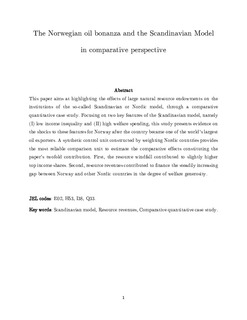| dc.contributor.author | Iacono, Roberto | |
| dc.date.accessioned | 2018-08-14T11:34:12Z | |
| dc.date.available | 2018-08-14T11:34:12Z | |
| dc.date.created | 2018-08-13T10:19:13Z | |
| dc.date.issued | 2018 | |
| dc.identifier.issn | 0888-7233 | |
| dc.identifier.uri | http://hdl.handle.net/11250/2557882 | |
| dc.description.abstract | This paper aims at highlighting the effects of large natural resource endowments on the institutions of the so-called Scandinavian or Nordic model, through a comparative quantitative case study. Focusing on two key features of the Scandinavian model, namely (a) low income inequality and (b) high welfare spending, this study presents evidence on the shocks to these features for Norway after the country became one of the world’s largest oil exporters. A synthetic control unit constructed by weighting Nordic countries provides the most reliable comparison unit to estimate the comparative effects constituting the paper’s twofold contribution. First, the resource windfall did not contribute to significantly higher top income shares. Second, resource revenues contributed to finance the steadily increasing gap between Norway and other Nordic countries in the degree of welfare generosity. | nb_NO |
| dc.language.iso | eng | nb_NO |
| dc.publisher | Springer Verlag | nb_NO |
| dc.title | The Norwegian Oil Bonanza and the Scandinavian Model in Comparative Perspective | nb_NO |
| dc.type | Journal article | nb_NO |
| dc.description.version | submittedVersion | nb_NO |
| dc.source.journal | Comparative Economic Studies | nb_NO |
| dc.identifier.doi | https://doi.org/10.1057/s41294-018-0071-7 | |
| dc.identifier.cristin | 1601412 | |
| dc.description.localcode | This is a pre-print of an article published in [Comparative Economic Studies]. The final authenticated version is available online at: https://doi.org/10.1057/s41294-018-0071-7 | nb_NO |
| cristin.unitcode | 194,67,90,0 | |
| cristin.unitname | Institutt for sosialt arbeid | |
| cristin.ispublished | true | |
| cristin.fulltext | preprint | |
| cristin.qualitycode | 1 | |
